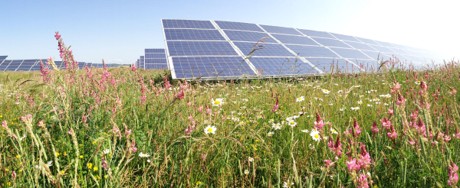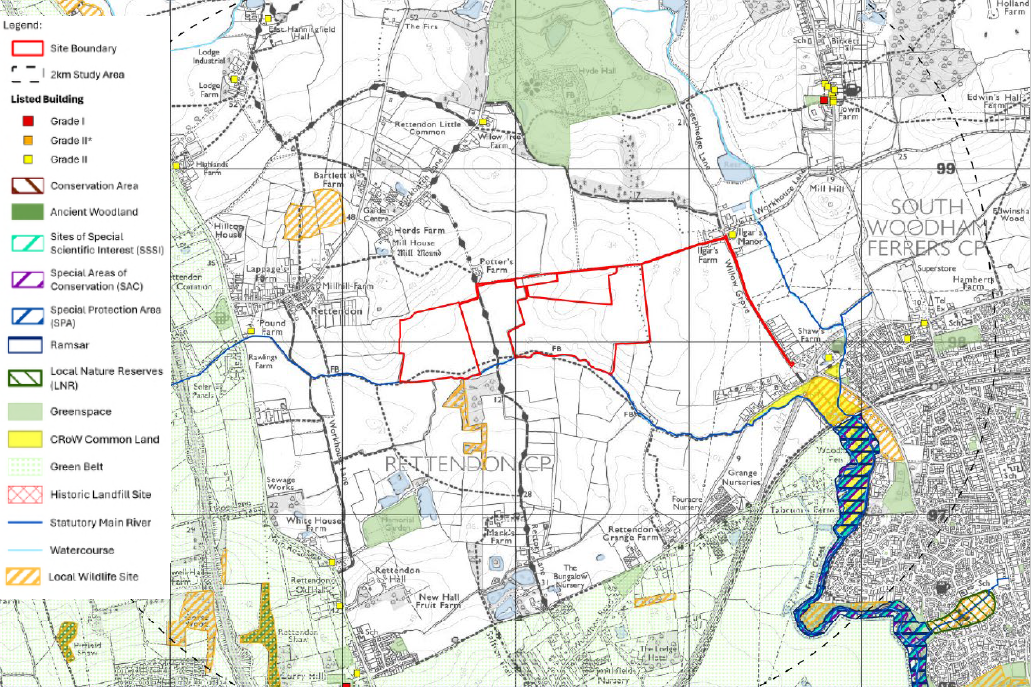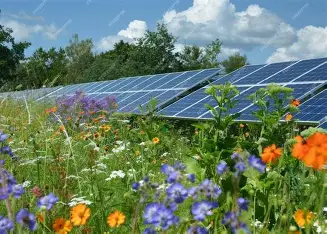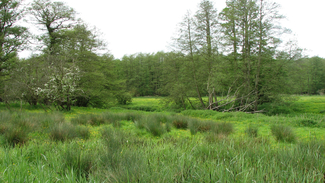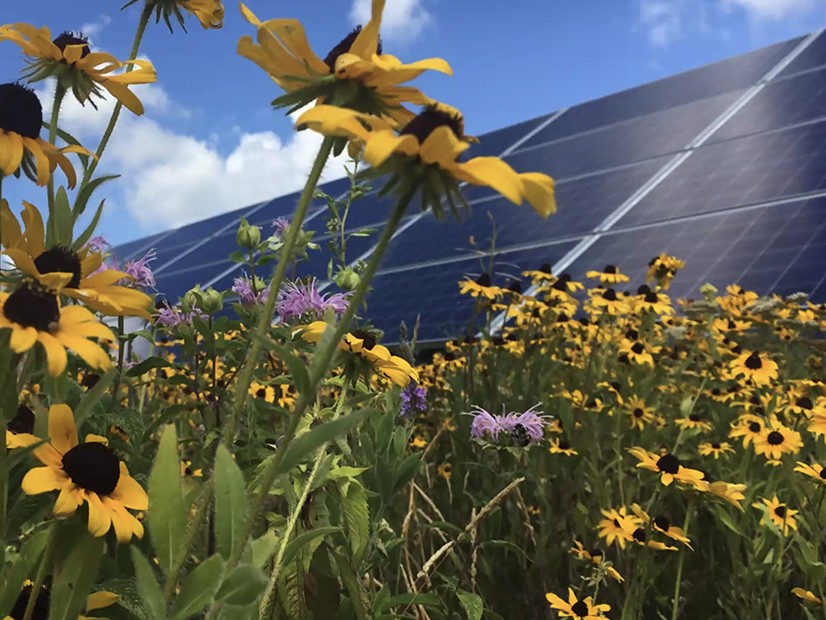Please note that this consultation has now closed, but that there will be a further opportunity to comment directly to the Council once the application is made.
ABOUT THE PROJECT
Lanpro is acting as a planning consultant to Infrabee, who are proposing to develop a new solar farm, to be known as Willow Grove Solar Farm.
The transition to a low carbon energy system is necessary to avoid the catastrophic effects of climate change. The UK’s legal climate change commitment requires achieving net-zero greenhouse gas emissions by 2050 and more renewable energy generation is needed to meet this target. Solar farms offer a low cost and safe form of renewable energy generation. Solar-powered electricity reduces the levels of carbon dioxide that are being emitted into the atmosphere by replacing the demand on electricity generation from fossil fuels. The temporary ‘rewilding’ of the land, through the provision of species rich grassland beneath and around the panels within a solar farm and the delivery of new boundary landscaping, results in considerable increases in biodiversity and provides new habitats for wildlife. It also allows the land to rest, which can improve the quality of the soil.
Please note that this consultation has now closed, but that there will be a further opportunity to comment directly to the Council once the application is made.
ABOUT THE PROJECT
Lanpro is acting as a planning consultant to Infrabee, who are proposing to develop a new solar farm, to be known as Willow Grove Solar Farm.
The transition to a low carbon energy system is necessary to avoid the catastrophic effects of climate change. The UK’s legal climate change commitment requires achieving net-zero greenhouse gas emissions by 2050 and more renewable energy generation is needed to meet this target. Solar farms offer a low cost and safe form of renewable energy generation. Solar-powered electricity reduces the levels of carbon dioxide that are being emitted into the atmosphere by replacing the demand on electricity generation from fossil fuels. The temporary ‘rewilding’ of the land, through the provision of species rich grassland beneath and around the panels within a solar farm and the delivery of new boundary landscaping, results in considerable increases in biodiversity and provides new habitats for wildlife. It also allows the land to rest, which can improve the quality of the soil.
Infrabee is a venture between two very different but complementary organisations: Infraland and Boultbee Brooks. Infraland is an infrastructure development company focusing on low-carbon technology, while Boultbee Brooks’s expertise is very much rooted in real estate development. After previously partnering together on several renewables projects in the UK, we have now brought our collective experience, pioneering spirit, and shared vision for the future of renewables, together as Infrabee.
Infrabee is a venture between two very different but complementary organisations: Infraland and Boultbee Brooks. Infraland is an infrastructure development company focusing on low-carbon technology, while Boultbee Brooks’s expertise is very much rooted in real estate development. After previously partnering together on several renewables projects in the UK, we have now brought our collective experience, pioneering spirit, and shared vision for the future of renewables, together as Infrabee.
This site was carefully selected to ensure that it meets technical and environmental criteria, including a viable grid connection nearby which is capable of accepting the power generated. Being free from statutory environmental and historic designations, along with the site's topography, the site’s low agricultural land grade, and the site’s limited visibility from public areas were all factors in choosing this location.
This site was carefully selected to ensure that it meets technical and environmental criteria, including a viable grid connection nearby which is capable of accepting the power generated. Being free from statutory environmental and historic designations, along with the site's topography, the site’s low agricultural land grade, and the site’s limited visibility from public areas were all factors in choosing this location.
- The site is located on land c. 975m to the north-west of South Woodham Ferrers, c. 425m to the east of Rettendon Common and c. 870m to the south of the Royal Horticultural Society Hyde Hall.
- The solar farm will have a generating capacity of circa 26 megawatts (MW) of renewable energy.
- The proposed solar farm, together with the proposed new landscaping, below ground cable and access route cover an area of circa 45 hectares (111 acres).
- The solar farm will be operational for a period of up to 40 years, after which the panels and supporting infrastructure would be decommissioned and removed from the site and as many items as possible will be recycled or re-purposed, with the site returned to farmland.
- The development will connect to the UK Power Networks distribution network via a new underground cable to the existing South Woodham Primary Substation, which is located on Willow Grove to the southeast of the site.
- Natural England's ALC map shows the site as Grade 3 agricultural land and surveys confirm the site to be Grade 3b. As set out in the National Planning Policy Framework, Grade 3b is not considered to be best and most versatile agricultural land.
A site of this size has the potential to deliver:
- 26MW generating capacity
- Approx. 10,500 homes powered each year
- Reduction in CO2 emissions equivalent to approx. 3,200 petrol cars over 40 years
- The site is located on land c. 975m to the north-west of South Woodham Ferrers, c. 425m to the east of Rettendon Common and c. 870m to the south of the Royal Horticultural Society Hyde Hall.
- The solar farm will have a generating capacity of circa 26 megawatts (MW) of renewable energy.
- The proposed solar farm, together with the proposed new landscaping, below ground cable and access route cover an area of circa 45 hectares (111 acres).
- The solar farm will be operational for a period of up to 40 years, after which the panels and supporting infrastructure would be decommissioned and removed from the site and as many items as possible will be recycled or re-purposed, with the site returned to farmland.
- The development will connect to the UK Power Networks distribution network via a new underground cable to the existing South Woodham Primary Substation, which is located on Willow Grove to the southeast of the site.
- Natural England's ALC map shows the site as Grade 3 agricultural land and surveys confirm the site to be Grade 3b. As set out in the National Planning Policy Framework, Grade 3b is not considered to be best and most versatile agricultural land.
A site of this size has the potential to deliver:
- 26MW generating capacity
- Approx. 10,500 homes powered each year
- Reduction in CO2 emissions equivalent to approx. 3,200 petrol cars over 40 years
We have prepared the site layout shown to the right. The design of our proposals respond, where appropriate, to technical studies and consultation feedback received to date.
All of our solar farms include minimum separation distances between solar panels of 3 meters. Biodiversity enhancements such as species rich grassland can be implemented between the panels. The development will result in notable ecological and landscape improvements through the proposed planting.
The development would consist of static rows of photovoltaic (PV) solar panels fixed onto a metal framework supported by either single or double mounted posts, together with supporting infrastructure, inverters and transformers (to be housed in cabinets), a customer substation and DNO substation, and a storage container, access, boundary fencing and new landscaping.
- The panel height will vary depending on the site’s topography, but on average they will be
approximately 3m in height from ground level. - The metal posts would be pile-driven into the ground.
- The panels would be laid out in straight rows west to east across the field set at vertical angle of between 20 and 25 degrees.
- The final number of panels depends on a variety of factors such as the capacity of each panel and the design of the rows of panels.
- None of the on-site infrastructure cabinets are to be greater than 4m tall.
- The site will have a perimeter wide paladin fence with a maximum height of 2.5m, as well as CCTV cameras facing into the site. There would be no need for floodlighting.
- Existing boundary hedgerows will be maintained and reinforced where needed and new areas of
wet woodland, scrub and meadow mosaic are proposed on the boundaries of the site, together
with woodland planting along Swan Lane, resulting in significant ecological and landscape
improvements. - Historic field boundaries, previously removed to accommodate modern farming practices, will
be reinstated, delivering heritage, landscape, and ecological benefits.
We have prepared the site layout shown to the right. The design of our proposals respond, where appropriate, to technical studies and consultation feedback received to date.
All of our solar farms include minimum separation distances between solar panels of 3 meters. Biodiversity enhancements such as species rich grassland can be implemented between the panels. The development will result in notable ecological and landscape improvements through the proposed planting.
The development would consist of static rows of photovoltaic (PV) solar panels fixed onto a metal framework supported by either single or double mounted posts, together with supporting infrastructure, inverters and transformers (to be housed in cabinets), a customer substation and DNO substation, and a storage container, access, boundary fencing and new landscaping.
- The panel height will vary depending on the site’s topography, but on average they will be
approximately 3m in height from ground level. - The metal posts would be pile-driven into the ground.
- The panels would be laid out in straight rows west to east across the field set at vertical angle of between 20 and 25 degrees.
- The final number of panels depends on a variety of factors such as the capacity of each panel and the design of the rows of panels.
- None of the on-site infrastructure cabinets are to be greater than 4m tall.
- The site will have a perimeter wide paladin fence with a maximum height of 2.5m, as well as CCTV cameras facing into the site. There would be no need for floodlighting.
- Existing boundary hedgerows will be maintained and reinforced where needed and new areas of
wet woodland, scrub and meadow mosaic are proposed on the boundaries of the site, together
with woodland planting along Swan Lane, resulting in significant ecological and landscape
improvements. - Historic field boundaries, previously removed to accommodate modern farming practices, will
be reinstated, delivering heritage, landscape, and ecological benefits.
The Planning Process
We intend to submit a full planning application to Chelmsford City Council once we have reviewed the responses received to this consultation and made any required updates to the proposed design.
The proposed design has sought to respond to the recommendations of a number of technical assessments which are ongoing and include the following:
Landscape and Visual Impact
A Landscape and Visual Assessment (LVA) is being undertaken in accordance with a methodology compliant
with The Landscape Institute and Institute of Environmental Management and Assessment Guidelines. The
layout of the development has been informed by an assessment of landscape and visual sensitivities and the
proposed design aims to minimise effects on visual amenity and landscape character and will deliver notable
improvements through new landscaping wherever possible
Ecology
An assessment of the site’s ecological sensitivity has been undertaken. The layout of the site and the proposed landscape planting includes measures that will notably enhance local biodiversity, as well as delivering new habitats through tree, hedgerow, meadow, and scrub planting.
Cultural Heritage
An assessment is being undertaken to understand the potential impacts on above and below ground heritage assets as well as the need for any further investigative work in consultation with the Essex County Archaeologist. The nearest listed buildings to the site include Grade II listed Ilgars Manor c. 500m to the east of the site, Grade II listed Pound Farmhouse c. 790m to the west of the site, and Grade II listed barn at Winters Farm c. 1km to the north of the site. Additionally, the Grade II listed Milestones is c. 1km to the southwest of the site.
Transport and Access
During the construction period, it is estimated that that there will be 2-3 HGV trips per day. Once operational, traffic movements will be limited to no more than a single car or van per week with parking provided on site.
Glint and Glare and Noise
An assessment of the potential effects of reflected sunlight (referred to as glint) from the proposed solar farm
on receptors in the vicinity of the site has been undertaken. No glint or glare impacts are anticipated as a
result of the development. A baseline sound survey has been undertaken, which has informed the layout of
the proposed development, ensuring that the existing background sound levels are not exceeded.
Flood Risk
A flood risk assessment and drainage strategy is being prepared to ensure that the proposed development does not increase the risk of flooding both on or off site.
The majority of the Site is located in Flood Zone 1, the lowest risk of flooding. Parts of the Site along the south boundary are located in Flood Zone 2. The proposed layout has been designed to avoid development in all fluvial flood risk areas.
Some parts of the Site are subject to surface water flooding, ranging from low to high risk. The Site will be designed so that the proposed panels and cabinets avoid all areas of surface water flood risk.
The Site would remain landscaped with grassland/vegetation surrounding and beneath the solar panels. The rows of solar panels do not prevent direct infiltration into the ground.
The proposed infrastructure cabinets will create a small increase in impermeable area. The flood risk assessment and surface water drainage strategy will seek to ensure that the current discharge routes and rates are retained as existing, to ensure that the risk of flooding both on and off site is not increased.
The Planning Process
We intend to submit a full planning application to Chelmsford City Council once we have reviewed the responses received to this consultation and made any required updates to the proposed design.
The proposed design has sought to respond to the recommendations of a number of technical assessments which are ongoing and include the following:
Landscape and Visual Impact
A Landscape and Visual Assessment (LVA) is being undertaken in accordance with a methodology compliant
with The Landscape Institute and Institute of Environmental Management and Assessment Guidelines. The
layout of the development has been informed by an assessment of landscape and visual sensitivities and the
proposed design aims to minimise effects on visual amenity and landscape character and will deliver notable
improvements through new landscaping wherever possible
Ecology
An assessment of the site’s ecological sensitivity has been undertaken. The layout of the site and the proposed landscape planting includes measures that will notably enhance local biodiversity, as well as delivering new habitats through tree, hedgerow, meadow, and scrub planting.
Cultural Heritage
An assessment is being undertaken to understand the potential impacts on above and below ground heritage assets as well as the need for any further investigative work in consultation with the Essex County Archaeologist. The nearest listed buildings to the site include Grade II listed Ilgars Manor c. 500m to the east of the site, Grade II listed Pound Farmhouse c. 790m to the west of the site, and Grade II listed barn at Winters Farm c. 1km to the north of the site. Additionally, the Grade II listed Milestones is c. 1km to the southwest of the site.
Transport and Access
During the construction period, it is estimated that that there will be 2-3 HGV trips per day. Once operational, traffic movements will be limited to no more than a single car or van per week with parking provided on site.
Glint and Glare and Noise
An assessment of the potential effects of reflected sunlight (referred to as glint) from the proposed solar farm
on receptors in the vicinity of the site has been undertaken. No glint or glare impacts are anticipated as a
result of the development. A baseline sound survey has been undertaken, which has informed the layout of
the proposed development, ensuring that the existing background sound levels are not exceeded.
Flood Risk
A flood risk assessment and drainage strategy is being prepared to ensure that the proposed development does not increase the risk of flooding both on or off site.
The majority of the Site is located in Flood Zone 1, the lowest risk of flooding. Parts of the Site along the south boundary are located in Flood Zone 2. The proposed layout has been designed to avoid development in all fluvial flood risk areas.
Some parts of the Site are subject to surface water flooding, ranging from low to high risk. The Site will be designed so that the proposed panels and cabinets avoid all areas of surface water flood risk.
The Site would remain landscaped with grassland/vegetation surrounding and beneath the solar panels. The rows of solar panels do not prevent direct infiltration into the ground.
The proposed infrastructure cabinets will create a small increase in impermeable area. The flood risk assessment and surface water drainage strategy will seek to ensure that the current discharge routes and rates are retained as existing, to ensure that the risk of flooding both on and off site is not increased.
Solar farms can be built relatively quickly compared with many other forms of energy development. Any disruption is minimal and well controlled by adherence to existing regulations administered by Chelmsford City Council. Key information is outlined below.
Construction Information
A typical construction period for a solar farm at this scale is around 9-12 months. During the construction period, it is estimated that that there will be 2-3 HGV trips per day. Whilst this figure is an average, there will often be a higher volume earlier in the construction period and less towards the end.
A Construction Traffic Management Plan (CTMP) will be agreed with the Local Highways Authority ahead of any construction.
Access Information
The site will be accessed from Willow Grove to the east, via an existing farm track known as Swan Lane. During the operational phase of the development, it is estimated that a small van will access the site once per week for maintenance purposes.
Cable Route Information
The development would connect to the UK Power Networks distribution network via a new underground cable, along the edge of Swan Lane and then within the highway, to the existing South Woodham Primary Substation, which is located on Willow Grove to the southeast of the site.
Solar farms can be built relatively quickly compared with many other forms of energy development. Any disruption is minimal and well controlled by adherence to existing regulations administered by Chelmsford City Council. Key information is outlined below.
Construction Information
A typical construction period for a solar farm at this scale is around 9-12 months. During the construction period, it is estimated that that there will be 2-3 HGV trips per day. Whilst this figure is an average, there will often be a higher volume earlier in the construction period and less towards the end.
A Construction Traffic Management Plan (CTMP) will be agreed with the Local Highways Authority ahead of any construction.
Access Information
The site will be accessed from Willow Grove to the east, via an existing farm track known as Swan Lane. During the operational phase of the development, it is estimated that a small van will access the site once per week for maintenance purposes.
Cable Route Information
The development would connect to the UK Power Networks distribution network via a new underground cable, along the edge of Swan Lane and then within the highway, to the existing South Woodham Primary Substation, which is located on Willow Grove to the southeast of the site.
Please note that this consultation is now closed, but there will be a further opportunity to provide comments directly to the Council once the planning application is made.
Please note that this consultation is now closed, but there will be a further opportunity to provide comments directly to the Council once the planning application is made.



